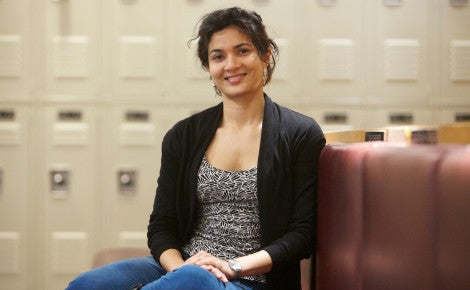June 15, 2015 — People concerned about the food they eat have been instructed to read the nutrition labels on the back of food products. Yet those labels can be intimidating and confusing. You want to make healthy choices, but how much, exactly, is a gram? How many grams of sodium are too many? And what about those “serving sizes”—which can vary even among very similar products from the same brand?
Improving consumer access to nutrition information that is useful and understandable is one of the goals of research being conducted by Neha Khandpur, SD ’16, in Harvard T.H. Chan School of Public Health’s Department of Nutrition.
Exercising good health
Nutrition and health have always been part of Khandpur’s life. She grew up in India, in a family that emphasized physical activity and good nutrition. “I think even when I was young I could understand how those two elements affected my health for the better,” she said. “My brother and I were raised to be extremely active, and my mother was very particular about the kinds of food we ate and the ways in which they were cooked. She cooked very simple, basic meals that brought out the food’s inherent flavors.”
After completing undergraduate degrees in nutrition and sport science, Khandpur became a consultant on physical activity and nutrition at health care centers in India, working with clients one on one. But she soon noticed that she was seeing the same health issues in many different people and realized that larger factors than just each person’s lifestyle must be involved. “I saw how better-designed policies could influence the health of a vast number of people,” she said. “That was when my trajectory changed from being very much a one-on-one consultant to researching public health and the bigger factors at play.”
Khandpur came to Harvard Chan School in 2011 to pursue her doctoral studies. In 2012, she was the inaugural recipient of the Prajna Chair’s Scholarship in Public Health Nutrition, established by anonymous donors to recognize the leadership and distinction of the Department of Nutrition’s chair, Walter Willett. The scholarship is funding her doctoral work.
Studying consumer behavior
Khandpur has a broad interest in obesity prevention, using nutrition and physical activity as levers of change. Her dissertation focuses on understanding consumer behavior, specifically looking at how consumers interact with food policy. In this area, she’s working with Christina Roberto, assistant professor of social and behavioral sciences and nutrition and principal investigator of the PEACH Lab, to study consumer behavior regarding nutrition labels.
Studies have shown, notes Khandpur, that consumers are not comfortable working with numbers and percentages—both of which are featured prominently on nutrition labels. “If we can come up with strategies to improve consumers’ ability to understand the labels’ content, it will mean that a huge segment of the society that previously was not able to access that information will now understand it and, we hope, make healthier food choices for themselves,” Khandpur said. Such changes would especially benefit people who are vulnerable to conditions such as obesity and chronic diseases, she added.
Indeed, the U.S. Food and Drug Administration (FDA) recently decided to revamp the nutrition labels. To inform the ultimate decision on the label format, Khandpur and Roberto are researching strategies such as presenting nutrition information qualitatively—for example, as high, medium, and low levels of certain nutrients in a product—and displaying information in teaspoons, for example, instead of grams. Discussions about the new labels are still ongoing, with no finalized version yet promulgated. “We are working to ensure that our evidence-based results will influence the new FDA label templates,” says Khandpur. “We’ve kept the FDA and the Center for Science in the Public Interest informed of the goals of our study and hope the results from our work influence their policies and consumer education efforts.”
Khandpur’s work is not designed to sit on a shelf but to be out in the world creating change. “I would like my research to have an impact outside of academia as much as I possibly can,” she said. “I want to look beyond just being able to publish my results. I’d like to be able to translate them in some meaningful way to inform policy and programs that directly influence the health of the population at large. That’s what I’m aiming for.”
— photo: Kent Dayton
